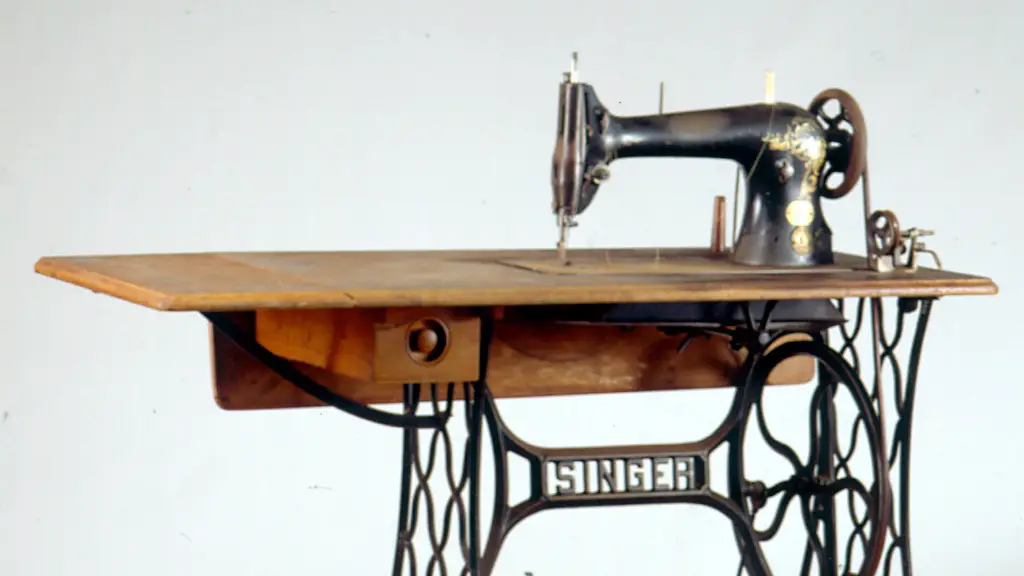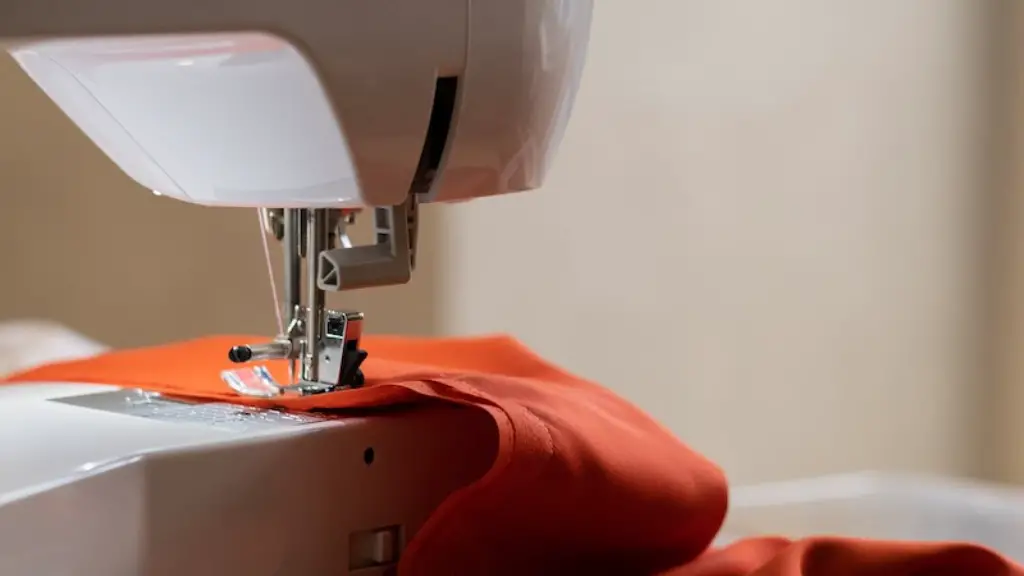Invisible thread has become an increasingly popular choice among sewers in recent years, due to its versatility and ease of use. It is ideal for embroidering onto delicate fabrics and for hemming lightweight garments, making it an attractive option for craftspeople who want to make high quality, professional looking garments. But can you use invisible thread in a sewing machine?
The answer is yes – invisible thread is suitable for use in a sewing machine. This is largely down to the fact that invisible thread is very thin and lightweight, meaning it can pass through the fine machinery of a sewing machine without causing any damage or clogging up the mechanisms. It also has excellent knot-holding ability, which helps to ensure that the stitches created don’t come undone.
However, while invisible thread can be used in a sewing machine, it is important to take certain precautions to ensure that the thread isn’t damaged or snagged in the process. One of the main challenges with sewing with invisible thread is that it can easily become tangled in the machine’s mechanisms, which can cause the thread to break. To avoid this, it’s best to use a quality thread such as Gütermann Invisible 100 or Sulky Invisible Thread, which are designed to be smoother and more flexible. Additionally, use a piece of fine sandpaper to lightly roughen up the outside of the thread before use, this will help the thread slip between the machine’s tensioners more easily.
Invisible thread can also be prone to breaking in a sewing machine, so it’s important to use the correct needle size and to adjust the tension correctly. The best needles to use for invisible thread are size 80/12 sharp needles. These needles are much finer than standard size needles and will help avoid the thread from breaking due to excess tension. The tension should also be adjusted for the thinner thread; for best results, set the tension to between 3 and 4.
To summarise, invisible thread is suitable for use in a sewing machine, but it is important to take precautions to prevent the thread from becoming tangled or damaged while sewing. The best needle size to use is 80/12 sharp needles and the tension should be set to between 3 and 4 in order to create strong, neat stitches. With these simple steps in place, using invisible thread in a sewing machine can be a great way to create high quality garments quickly and easily.
Benefits of Using Invisible Thread
Using invisible thread in a sewing machine can offer many benefits, from professional-looking results to convenience. As this type of thread is very thin and lightweight, it can be used to create very neat and fine stitches that enhance the look of garments, such as on hems or delicate fabrics. In addition, it’s much easier to use than traditional threads as it passes through the machine’s mechanisms with ease. It also requires less tension, making it much faster to sew with.
Invisible thread is also ideal for those who want to make more intricate details, such as beadwork or applique. The fine thread allows the sewers to make delicate, intricate designs without worrying about the thread breaking or fraying. It also creates a seamless look, which is perfect for creating an invisible seam or hem line.
Finally, using invisible thread in a sewing machine can save time and effort by eliminating the need for hand-sewing. This type of thread is much faster to work with and it is also much lighter and more flexible than standard thread, which makes it easier to handle and less prone to tangling or knotting.
Tips for Using Invisible Thread in a Sewing Machine
Working with invisible thread can be challenging, as the thread is so thin and delicate. To help ensure successful results, there are a few simple tips that sewers can follow when using invisible thread in a sewing machine.
The most important tip is to remember to use the correct needle size. As noted earlier, invisible thread needs a very thin and sharp needle, so a size 80/12 sharp needle is the best choice. Additionally, always reduce the tension on the machine, as this will help the thread move through the mechanisms more easily and reduce the risk of breakage.
It is also important to use the right type of invisible thread. Quality invisible thread such as Gütermann Invisible 100 or Sulky Invisible Thread will produce the best results, as it is designed to work smoothly within a sewing machine. Finally, make sure to lightly roughen up the thread with a piece of fine sandpaper before starting to sew – this will help reduce the chances of the thread becoming snagged or tangled.
Importance of Following the Sewing Machine’s Instructions
When using invisible thread in a sewing machine, it’s important to follow the instructions and settings recommended in the manual. Ignoring the settings or changing them incorrectly can result in the thread breaking or causing damage to the sewing machine. Therefore, thoroughly read the manual to ensure that the correct settings are used and that the correct needle size is selected.
It is also important to regularly check the machine’s tension and needle, as they may need to be adjusted depending on the project. For example, when using a heavier thread, the tension should be increased to ensure that the stitches won’t come loose. On the other hand, when using a thinner thread such as invisible thread, it is best to reduce the tension to prevent the thread from breaking.
Finally, make sure to remember to regularly clean and lubricate the machine according to the instructions in the manual. This will help ensure that the machine is running smoothly and that the invisible thread is passing through the mechanisms without any issues.
Troubleshooting Tips for Using Invisible Thread
Despite its advantages, working with invisible thread can present some difficulties. Fortunately, there are a few simple steps you can take to troubleshoot these issues and ensure successful results.
Firstly, make sure that the thread is passing evenly through the machine. If there are any kinks or tangles, carefully untangle them with a pin. Additionally, it’s important to make sure the thread is not too tight – very tight threads can cause the stitching to become uneven and can even break the needle. If the thread is too tight, adjust the tension settings accordingly.
It is also important to pay attention to the bobbin. If the bobbin is not working correctly, the thread may not feed through the machine correctly. Therefore, check that the bobbin is inserted correctly and ensure that it is not empty. Additionally, use a quality bobbin, as this will help prevent the thread from becoming snagged.
Finally, if the thread keeps breaking, the problem may lie with the needle. Ensure that you are using the correct needle size and shape for the thread, as this will help to ensure that the thread is not damaged by too much tension. If this doesn’t solve the problem, try a new needle – this should help the invisible thread pass through the machine without any issues.
Additional Considerations When Working with Invisible Thread
When working with invisible thread, there are a few other factors to consider to ensure successful results. Firstly, it’s important to choose the right fabric, as some fabrics are more prone to breaking the thread than others. For example, stretchy or cumbersome fabrics can make it more difficult to work with the thread, so it’s best to avoid using these.
If possible, it is also best to choose a backing fabric that is a similar colour to the fabric that the invisible thread is being sewn onto. This will help to make the stitches less visible and will also give the garment a more professional finish. Additionally, make sure to use the correct stitch length when working with invisible thread; shorter stitches, such as 1.5mm or 2mm, are best as this will reduce the risk of the thread bunching and breaking.
Finally, it is important to check the stitches regularly when working with invisible thread, as this will help to ensure that the stitches are secure and that the fabric isn’t snagging on the thread. During the sewing process, check the stitches periodically with a seam ripper and remove any loose threads or knots that may have formed.





